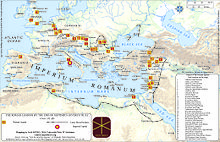
Back المرسوم الأنطوني Arabic Эдыкт Каракалы Byelorussian Едикт на Каракала Bulgarian Constitutio Antoniniana Breton Edicte de Caracal·la Catalan Constitutio Antoniniana Czech Constitutio Antoniniana German Edicto de Caracalla Spanish Édit de Caracalla French Constitutio Antoniniana Hungarian
This article needs additional citations for verification. (October 2013) |


The Constitutio Antoniniana (Latin for "Constitution [or Edict] of Antoninus"), also called the Edict of Caracalla or the Antonine Constitution, was an edict issued in AD 212[1] by the Roman emperor Caracalla. It declared that all free men in the Roman Empire were to be given full Roman citizenship (and by extension all free women in the Empire were to be given the same rights as Roman women, such as the jus trium liberorum).
Before AD 212, full Roman citizenship was mostly only held by inhabitants of Roman Italy. Colonies of Romans established in the provinces, Romans (or their descendants) living in provinces, the inhabitants of various cities throughout the Empire, and small numbers of local nobles (such as kings of client countries) also held full citizenship. Provincials, on the other hand, were usually non-citizens, although some held the Latin rights. Veterans of the Auxilia were also granted Roman citizenship on discharge. Being a Roman citizen remained a well sought-after status until 212.[2]
As a result, vast numbers of new citizens assumed the nomen Aurelius, in honour of their patron (whose full name was Marcus Aurelius Antoninus), including several emperors: seven of the eleven emperors between Gallienus and Diocletian (Claudius Gothicus, Quintillus, Probus, Carus, Carinus, Numerian and Maximian) bore the name Marcus Aurelius.[3][4]
- ^ Richard Lim, "Late Antiquity," in The Edinburgh Companion to Ancient Greece and Rome (Edinburgh University Press, 2010), p. 114.
- ^ Besson, Arnaud (2017-01-01). Fifty Years before the Antonine Constitution: Access to Roman Citizenship and Exclusive Rights. Brill. doi:10.1163/9789004352612_010. ISBN 978-90-04-35261-2.
- ^ Salway, p.136[full citation needed]
- ^ Blanco-Pérez, Aitor (2016). "Nomenclature and Dating in Roman Asia Minor: (M.) Aurelius/a and the 3 rd Century AD". Zeitschrift für Papyrologie und Epigraphik. 199: 271–293. JSTOR 26603724.